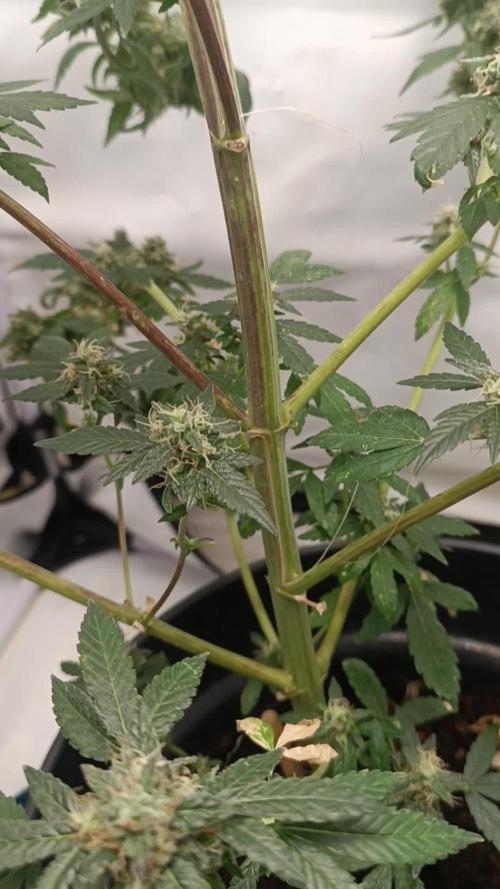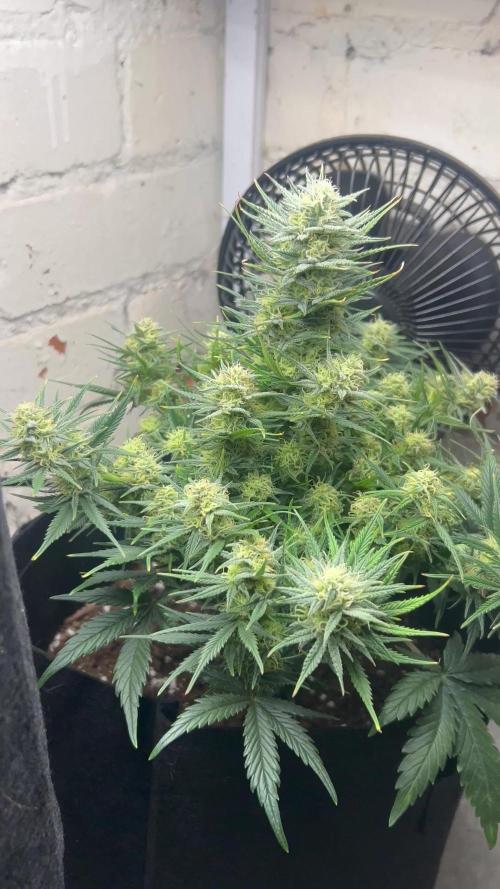The Grow Awards 2026 🏆 

































Likes
Comments
Share


@qwertyuiop0987
Follow
Los días han estado fríos por las noches y más oscuro en el día.
Está amaneciendo más tarde.
Aumento de la dosis de nutriente vegetativo a 5ml/L
Likes
17
Share


@Naujas
Follow
She is much prettier than she was a week ago :) I remembered that I have my first grow light, which is more compact and it will give me more space, so I changed my light, now the girl's side branches get light too:) I add a lot of video memes, because I really want to win Iphone16 pro ;) and those who don't take risks don't drink champagne:) good luck to everyone.
Likes
9
Share


@Garamantes
Follow
After 3 days, when the temperature rose above 11 degrees, I could finally remove the greenhouse from the pet bottle.
I did the first fertilizing with Advanced nutrients Voodoo juice, Piranha and Tarantula for better development and protection of the root.
Unfortunately, the pet bottle greenhouse, which was dewy and dirty from snail slime, caused the main stem to pull out more than I would have liked.
I like it when the main stem is low and immediately starts to form secondary branches
Likes
43
Share


@Sabac
Follow
Semana 4 de flora están a full mis plantitas. Creciendo cada día más y más.
Sanitas.
Likes
22
Share


@Siriuz
Follow
And we are here now!
PPM is 450
Time to transplant this girl is at its 5th nod
Tomorrow I am going to place her
In a bigger pot probably get to record it
18/6 schedule
Using only floranova veggie and plain water
Nice mix super mega soil made by siriuz
#foxfarmnutrients
#generalhydroponics
Follow me at Instagram @cannagrowersiriuz
This red poison will rock
Likes
2
Share


@wolfvb
Follow
So our last week started, she is looking nice and ready and she is gaining weight.
I love the pink hints on it she looks very beautiful 😍 ❤️
Can't wait to try it out.
Hopefully she is as delicious as she looks 💦
24.11.25
So today I maxed some small amounts of char by rubbing here a bit as the tircomes are still clear so I decided to add some extra food and maybe stress here a bit. To make it grow more tircomes hopefully 😅
And Manged to up the humidity by closing the windows in the room, not much and I have to run the fan at the lowest!
German growers how it's for you ?
I feel the winter is abit dry.
Likes
20
Share


@eldruida_lamota
Follow
Buenas noches familia, como estáis, yo bien fumado 😂🤣 aparte intentaré actualizaros el diario.
Y es que esta farm cheese de Genofarm , esta espléndida, fijaos que color , que Salud, esta perfecta y es que controlando siempre el ph la humedad y la temperatura lograremos siempre estos resultados.
No nos podemos pasar con la alimentación, y dar siempre lo necesario en todo el proceso de crecimiento y floración.
Vuelvo agradecer a marshydro por la carpa y el foco , sin ellos este proyecto no es posible.
Www.mars-hydro.com
web: http://bit.ly/2uJAjgy
ts600: http://bit.ly/3cnv0Ev
code: an420
También agradecer a zambeza sus genéticas, tantos diarios no son posibles tampoco sin ellos.
Aviso que este cultivo va a ser de los últimos que practique con la gama de advanced nutrients, y para los siguientes traeré distintas tablas con productos AGROBETA que también tienen una amplia gama de fertilizantes para nuestras plantas.
Espero que estén pasando buen confinamiento entre buenos humos, la semana que viene vuelvo con más fumetillas.
Processing
Likes
23
Share


@SativaSteve88
Follow
Another week down few more to go can't wait!! First ever attempt of growing my own so really impatient to see the final results now and get to the finish line, that said all has went well upto now other than the size they reached haha, really started putting on weight now it seems and they smell lovely, excited to see the buds fatten and progress over these last few weeks up until harvest now, started 5 liberty haze also they are just coming upto 3 weeks now so check that diary out to, any comments info tips for the final stages appreciated
Likes
2
Share


@GrowChico
Follow
She is looking really good. I transplanted her to my springpot autopot system.
The pot is a nature's living soil and fox farms ocean forest.
Likes
22
Share


@ChachoGreenCrown
Follow
Excelente resultado el que hemos obtenido con estas cepas de kannabia, pero esta se lleva la palma.. para mi, es la favorita del cultivo. Ha sido la más fácil de cultivar, la que mejor se adapto en el espacio de cultivo.. bastante productiva y con una resina brutal.
Sabores cítrico y mango muy acentuado.. es una pasada fumar esta cepa.
Con esto damos por terminado el cultivo con kannabia.. disculpad la tardanza en publicar... tarde o temprano siemore cumplimos!
Hasta pronto amigos! Un saludo growers 💚👨🌾🏽
Likes
7
Share


@Mr_Pgrow
Follow
Still looks like a few weeks left in her, no rush.
She still seems relatively happy despite the heat, with a heat wave due next week....
Likes
55
Share


@w33dhawk
Follow
12.04.21 heute is Anfang der 4. Woche nach dem flip bin begeistert von den Ladys sie sind obwohl sie so viel stress mit machen mussten fleißig am blutenstände produzieren die trichom Produktion hat auch gut eingesetzt jedes mal wenn ich die Blätter unters netz schiebe und wenn ich gegen die Blüten komme kleben meine Hände und wenn das passiert verströmt sie einen angenehm cremigen Duft nach zitrone fast schon limoncello artig.......
13.04.21 hab heute mal wieder gegossen und wie immer jeden morgen Blätter unten halten sonnst war nix weiter....
14.04.21 moin leute der trottel des Tages ist wieder da hab mir heute (2 Tage nach dem gießen) meine gedanken gemacht bezüglich des absetzen der dünge Zusätze aufgrund von Green Sensation hab gedacht 4 in eins dann kann der rest ja weg und bin heute mal zufällig drauf gekommen beim Hersteller auf der Homepage zu gucken und siehe da ich trottel hätte sugar royal ganz normal weiter laufen lassen können werde es dann beim nächsten Guss wieder mit einschieben. Hab heute den Reflektor auf ganz weit gestellt damit ich mit der Lampe weiter runter komme bin jetzt heute auf 30cm an die spitzen gegangen und werde am Freitag weitere 5 cm nach unten gehen also auf 25 cm an die spitzen ran fahren da ich bei offenem wing und 30 cm nur 23,5 Grad an den spitzen habe solange die Pflanzen keine Stress Erscheinungen auf 25cm erleiden und die Temperatur stimmt bleib es dann auch auf 25 cm bis zur Spülung...
15.04.21 habe doch heute schon die Lampe auf 25 cm gesetzt bin wieder zu ungeduldig 24std hat der Tag das ist einfach zu lang für meine Geduld 😁 hab sonnst nur wie immer dafür gesorgt das alles an blattwerk sich unterm netzt hält....
16.04.21 hab es heute mal nur laufen lassen und beobachtet was die Blätter so machen muss morgen eindeutig wieder ran und unters netz stopfen 😒😒....
17.04.21 hab heute wieder die Blätter unters netz gestopft sonnst weiter nix los gewesen. Die Ladys halten die 25cm Lampen Abstand ganz gut aus bis jetzt, Temperatur liegt bei 25,4 Grad also noch vertretbar denke ich. Mal gucken was die Ladys bis Montag zum Licht druck sagen, wenn die spitzen heller werden geh ich zur not lieber wieder nen Stück hoch mit der Lampe.....
18.04.21 hab heut das gleiche wie jeden Tag gemacht, ich hab versucht die Welt-Herrschaft an mich zu reißen 😁😁, ne spass bei seite wie immer Blätter drücken und giessen war heut auch dran. Die Woche lief auch wieder erstaunlich gut hab zwar noch ne ganze ecke vor mir mit den Ladys aber ich bin zuversichtlich......
Likes
5
Share


@Squaregrouper
Follow
Today the ladies finally are cooling off a break in the extreme temperatures of the summer after a long Heatwave
Likes
30
Share


@DankeyeBeaverjuice
Follow
This grow gets a ten out of ten from me on behavioral attributes on how she grew through out all the stages of life. Vegging was an absolute pleasure, she thrived off the 125g of amendments, cal-mag, and kelp all the way to day 30. Once I noticed flower development I proceeded to give her, her first feeding of grow and bloom nutrients both at the same time @ a diluted mixture of 25% then proceeded to increase increments as needed into flower, cutting out the grow after two feedings. She has been to date one of the cheapest grows I've ever had, all that's left is to harvest, cure and smoke for the final conclusion on 3 bears auto from Mephisto. Hats off to the boys over there! All this did was get me excited to grow the remaining Mephistos I have stored away!
Processing
Likes
27
Share


@Silverback_Guerilla
Follow
2/17:
I spent a little time rearranging today. I bought some 32" x 14" plastic ventilated storage shelves and cut the legs down on two of them so I have some different-height platforms for the shorties in the garden. I should also be able to easily flush 6 plants in 5 gallon pots, or 9 plants in 3 gallon pots at a time now, that's a win!👈
2/18:
I debated whether to feed or not, and settled on watering them with about 1/2 gallon each. including bembe, cal-mag, signal, humic acid, and a little beastie bloomz.
The new dehumidifier is pulling about a gallon and a half per day from the air, so I should be able to feed them in a coupe of days.
I've reached the ceiling again with my lights and the tall one is still stretching a little bit. I sure hate to have to supercrop her too...my garden is looking so wild and untamed already...😳
2/19:
Rainy day outside, so I'm pulling in 99% humidity, plus the pots are still petty saturated, but the new dehumidifier is keeping up. RH is holding at about 45% today.👍
2/20:
Day 31 of flower...the taller plant grew another couple of inches overnight! Damnit!😟 After emptying the closet (again) today and supercropping more branches (and some of the same branches again), a semi-solution occurred to me that allowed me to raise the lights another 3-4 inches! Now I'm truly maxxed out...
These two plants couldn't be more different.
One twisted-leaf 2-footer that started budding up in the first week of flower, and one beautiful 4-footer that's been very slow to flower..
The structure on the taller/sativa-looking plant is very promising, though...many long colas, and stacking up well...👌
I really needed everybody to finish in the same week so I could get my Spring autos going...😶
I'm still hoping that the big one will hurry the fuck up and finish by the EHD(3/11), but it's not looking possible at this point...
I took photos and videos of all the plants today since I had to empty the closet and it wasn't a feeding day.
2/21:
I fed them today with about 3/4 gallon each including beastie bloomz, tiger bloom, big bloom, signal, bembe, and cal-mag...no grow big this time.
2/22:
The tall one grew another inch...i threatened to bind her up like one of Silky_Smooth's plants if she didn't stop growing immediately.
If she doesn't start budding up with serious urgency, she's gonna piss me off...my Spring auto grow must not be postponed!
2/23:
I ordered some terpinator because I'm not so sure about Signal's efficacy at this point....I'm usually dealing with odors more by now..
Likes
80
Share


@Roberts
Follow
FBT 2307 did really well. She has aone. Ice big colas. I did have a ph issue with wrong nutrition base that damaged leaves in early flowering. Once a new solution was given it had stopped. She has a earthy flowery smell. Loaded with frost, and buds feel dense. She will hang for 24 hours then go into the cannatrol. Thank you Athena, Mars Hydro, and Fast Buds. 🤜🏻🤛🏻🌱❄️🌱
Thank you grow diaries community for the 👇likes👇, follows, comments, and subscriptions on my YouTube channel👇. ❄️🌱🍻
Happy Growing 🌱🌱🌱
https://youtube.com/channel/UCAhN7yRzWLpcaRHhMIQ7X4g
Likes
22
Share


@TightNugs
Follow
Lovely colours coming and packing on the weight.
17 days since first pistils,flowering fast.
No issues so far 🤞🍁






















